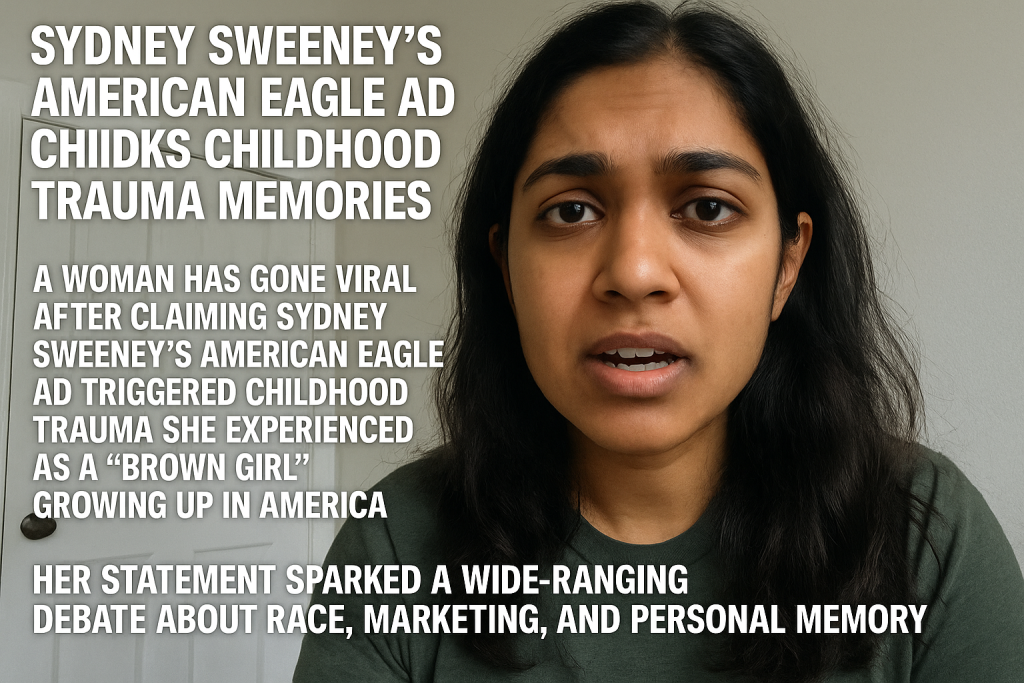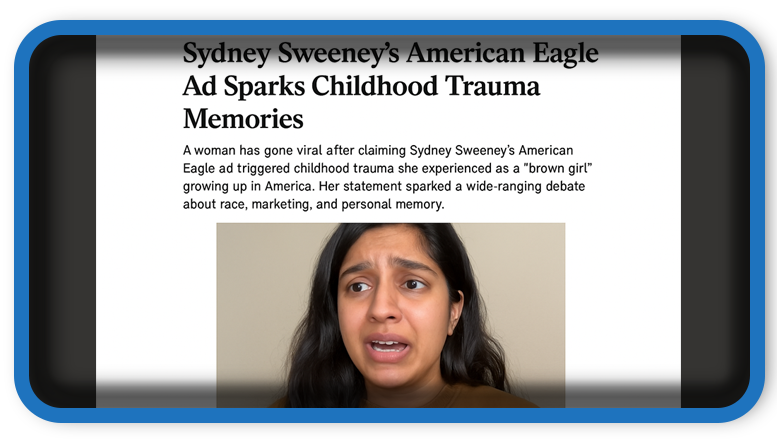⏲️ Estimated reading time: 5 min
Sydney Sweeney’s American Eagle Ad Sparks Childhood Trauma Memories. A woman has gone viral after claiming Sydney Sweeney’s American Eagle ad triggered childhood trauma she experienced as a “brown girl” growing up in America. Her statement sparked a wide-ranging debate about race, marketing, and personal memory.
Sydney Sweeney’s American Eagle Ad Reignites Painful Memories for Woman Who Grew Up as a “Brown Girl”
In today’s hyper-connected digital world, a seemingly innocent advertisement can quickly become a cultural flashpoint. That’s exactly what happened when a TikTok user posted a heartfelt video claiming that the latest American Eagle ad featuring actress Sydney Sweeney stirred up intense memories from her childhood. The woman, identifying as a “brown girl,” said the imagery and styling reminded her of the type of exclusion and beauty standards she struggled with while growing up.
The viral post has now opened up larger conversations on social media about representation, racial identity, and the emotional impacts of mainstream advertising.
🌟 The Ad in Question: Sydney Sweeney for American Eagle
Sydney Sweeney, known for her roles in Euphoria and The White Lotus, recently appeared in a summery and carefree campaign for American Eagle. The ad, full of denim, sunshine, and all-American aesthetics, was meant to inspire feelings of nostalgia and freedom.
However, not everyone saw it that way.
🎙️ The Woman’s Reaction: “I Felt Invisible as a Brown Girl”
In a now-viral TikTok, a woman described her visceral emotional reaction to the ad. She explained that while many viewers might see it as harmless or even empowering, it reminded her of the very spaces where she never felt welcome or represented.
“This ad didn’t just remind me of high school it reminded me of how excluded I felt. The blonde girl on the beach wasn’t me. I never saw anyone like me in those ads growing up. I wasn’t the standard of beauty. I was invisible.”
Her emotional response resonated with thousands of users who shared similar experiences, particularly from communities of color.

📢 Social Media Reacts: Empathy, Debate, and Division
The woman’s video sparked both empathy and criticism. Many TikTok users, particularly women of color, commented in support, sharing that they too had felt alienated by similar advertising campaigns in the past.
However, others pushed back, accusing the woman of overreacting or projecting personal trauma onto something innocuous. Some even defended Sydney Sweeney and American Eagle, arguing that nostalgia and aesthetics aren’t inherently exclusionary.
This mix of reactions reveals just how layered these discussions can become in a multicultural society.
🧠 Why It Matters: The Lingering Impact of Representation
Representation in media and marketing is more than a buzzword it has real psychological and social consequences. For children and teens especially, seeing people who look like them in aspirational roles can shape self-esteem, identity, and worldview.
When someone says an ad “triggered” childhood trauma, it’s not always about the content itself it’s about the memories and systems the content may unconsciously reinforce. For many “brown girls” growing up in predominantly white communities, fashion and beauty advertisements served as daily reminders of where they did and didn’t fit in.
💬 Marketing in the Era of Diversity
American Eagle, like many other major clothing brands, has made efforts to diversify its campaigns in recent years. But this incident highlights that progress is not just about checking boxes or featuring diverse models it’s about cultural sensitivity and understanding the emotional subtext of branding.
As one commenter put it:
“Diversity isn’t about who you put in the picture. It’s about how people feel when they see themselves or don’t in your story.”
👗 What Brands Can Learn From This Moment
This viral reaction is not an indictment of Sydney Sweeney or even American Eagle per se. Rather, it’s a teachable moment for brands to consider the emotional nuances of their imagery.
Here’s what brands can take away:
- Understand nostalgia’s double edge: It can be joyful for some, painful for others.
- Expand representation with intention: Diversity must feel authentic and inclusive.
- Listen to your audience: Social media offers real-time emotional feedback.
- Avoid romanticizing exclusionary aesthetics: They may appear harmless but carry historic weight.

🔍 Moving the Conversation Forward
This moment may seem like just another internet controversy, but it reveals deeper truths. Marketing shapes memory. Media creates meaning. And for those who’ve felt unseen, every new campaign is an opportunity to finally feel included or to relive past wounds.
So the next time you see a sunny beach ad with friends in denim, ask: “Who is missing from this picture?”
🔔For more tutorials like this, consider subscribing to our blog.
📩 Do you have questions or suggestions? Leave a comment or contact us!
🏷️ Tags: Sydney Sweeney, American Eagle ad, brown girl trauma, racial representation, nostalgia marketing, TikTok reactions, advertising controversy, body image, diversity in media, cultural sensitivity
📢 Hashtags: #SydneySweeney #AmericanEagle #RepresentationMatters #BrownGirl #TraumaResponse #TikTokViral #MediaImpact #AdControversy #DiversityInMarketing #InclusionMatters
Final Thoughts
This incident reminds us that even the most well-meaning media can hit a nerve. For some, it’s just denim. For others, it’s a doorway to decades of pain. The more we listen to these stories, the closer we come to building a world where everyone feels seen.
Only logged-in users can submit reports.
Discover more from HelpZone
Subscribe to get the latest posts sent to your email.

